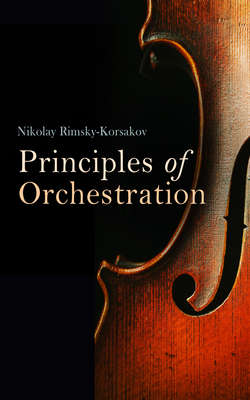Читать книгу Principles of Orchestration, with Musical Examples Drawn from His Own Works - Rimsky-Korsakov Nikolay - Страница 17
На сайте Литреса книга снята с продажи.
Harp.
ОглавлениеIn the orchestra, the harp is almost entirely an harmonic or accompanying instrument. The majority of scores require only one harp part, but in recent times composers have written for two or even three harps, which are sometimes compressed into the one part.
Note. Full orchestras should include three or even four harps. My operas Sadko, The Legend of the Invisible City of Kitesh, and The Golden Cockerel are designed for two harps, Mlada for three.
The special function of the harp lies in the execution of chords, and the florid figures springing from them. As only four notes at the most can be played by each hand, the notes of a chord should be written close together, with not too great a space between one hand and the other. The chords must always be broken (arpeggiato); should the composer wish otherwise he should notify it (non arpeggiato). In the middle and lower octaves the resonance of the strings is slightly prolonged, and dies away gradually. In changes of harmony the player stops the vibration of the strings with his hands, but, in quick modulations, this method is not feasible, and the mixture of one chord with another produces a discordant effect. It follows that more or less rapid figures can only be realised clearly and neatly in the upper register of the harp, where the strings are shorter and harder in tone.
As a general rule, in the whole range of the harp:
only the notes of the first to the fourth octave are used; the extreme notes in both compasses may be employed in special circumstances, and for doubling in octaves.
The harp is essentially a diatonic instrument, since all chromatic passages depend on the manipulation of the pedals. For this reason the harp does not lend itself to rapid modulation, and the orchestrator is advised to bear this fact in mind. But the difficulty may be obviated by using two harps alternately.[10]
Note. I would remind the reader that the harp is not capable of double sharps or double flats. For this reason, certain modulations from one key to another one, adjacent to it can only be accomplished enharmonically. For instance, the transition from C flat, G flat or D flat, major to their minor subdominant chords or keys is not possible owing to double flats. It is therefore necessary to start enharmonically from the keys of B, F sharp or C sharp, major. Similarly, on account of double sharps, it is impossible to change from A sharp, D sharp or G sharp, minor to their respective dominant major chords or keys; B flat, E flat and A flat, minor must be the starting-points.
The technical operation known as glissando is peculiar to the harp alone. Taking for granted that the reader is conversant with the methods of acquiring different scales by means of double-notched pedals, it will be sufficient to remark that glissando scales produce a discordant medley of sound owing to the length of time the strings continue to vibrate, and therefore, as a purely musical effect, glissando can only be used in the upper octaves, quite piano, where the sound of the strings is sufficiently clear, yet not too prolonged. Forte glissando scales, entailing the use of the lower and middle strings are only permissible as embellishments. Glissando passages in chords of the seventh and ninth, enharmonically obtained, are much more common, and as the above reservations do not apply, every dynamic shade of tone is possible. Chords in harmonics can only consist of three notes written close together, two for the left hand and one for the right.
The tender poetic quality of the harp is adapted to every dynamic shade, but it is never a very powerful instrument, and the orchestrator should treat it with respect.
At least three, if not four harps in unison are necessary, if they are to be heard against a full orchestra playing forte. The more rapidly a glissando passage is played, the louder it will sound. Harmonic notes on the harp have great charm but little resonance, and are only possible played quite softly. Speaking generally, the harp, like the string quartet, pizzicato, is more an instrument of colour than expression.
